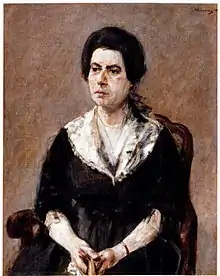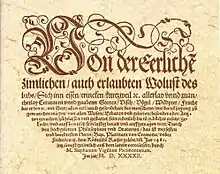Julie Elias | |
|---|---|
 Max Liebermann: Julie Elias (1914) | |
| Born | 6 June 1866 Berlin |
| Died | 1945 (aged 78–79) Lillehammer, Norway |
| Occupation | Writer |
| Nationality | German |
| Notable works | Styl, The Jewish Magazine, Die Dame, The New Cookbook |
| Partner | Julius Elias |
| Children | Ludwig Elias |
.jpg.webp)

Julie Elias (born 6 June 1866 in Berlin as Julie Levi; died spring 1945 in Lillehammer in occupied Norway) was a German fashion journalist and author of cookbooks, which also dealt with Jewish cuisine. She was worldly, highly educated, and during her lifetime was known beyond the borders of Germany as a culinary salonnière and successful writer. In 1938, persecuted as a Jew, she had to flee Germany. After the destruction of European Jewry in the Holocaust, there were hardly any traces of her left in the public memory.
Life
Julie Levi and the art historian Julius Elias married in 1888, they had a son Ludwig Elias (1891-1942). In 1890 they moved into the inherited house at Matthäikirchstraße 4 in Berlin, had a large circle of friends, cultivated conviviality and were particularly friends with the Liebermann couple, with whom they shared culinary pleasures, especially their love of French cuisine. As a hostess, Julie Elias was praised contemporarily as a "culinary artist.".[1]
Writer
Julie Elias was a fashion journalist as well as the author of books on practical lifestyle and cookbooks. Between 1915 and 1928, 28 articles by her appeared in the Berliner Tageblatt. She also wrote for the Berlin fashion journal Styl, the Jewish Magazine, founded in 1929, and the magazine Die Dame. In her articles, she combined fashion and cooking with Jewish culture, publishing recipes for the Sabbath in Die Dame, for example, or introducing a new fashionable style to conservative Jewish readers in Jüdisches Magazin.[2] She used literary quotations in her texts. In a 1921 article, for example, she conveyed to her readers the connection between the perception of art and the perception of taste by quoting Guy de Maupassant. In another from 1924, she linked Ludwig Börne's letters from Paris with the enthusiasm of German women for Parisian fashion, which was current at the time.[3]
In 1925, she published The New Cookbook, which also dealt with Jewish cuisine. It contained recipes for dishes that are traditionally prepared, especially for Passover, such as matzah. In addition, she described some recipes of prominent Jewish women in Germany at the time, including Martha Liebermann and the fashion journalist Elsa Herzog. Julie Elias' books on cooking and kitchen practice, however, are not just collections of recipes reduced to practical action. Rather, she also included knowledge of cultural history without devaluing craftsmanship.[4] In her books, she thought wittily about culinary arts, quoting from the works of eminent French and German gastrosophists such as Brillat-Savarin and Eugen von Vaerst. She wrote about the art of cooking: "For the rest, cooking is like any other artistic profession: only through practice does one attain proficiency, only through manual activity does one attain mastery. [...] Intelligence alone does not do it - a refined sensuality is necessary.“ In the introduction to the New Cookbook, she prefaced the motto Cooking - "the permitted voluptuousness of life"[5] and in the second edition in 1927 (Cooking) she added the explanation of an old monk's saying.
Nazi era
After the Nazis came to power in Germany in 1933, Elias was persecuted as a Jew. She travelled to Italy in 1934 and Switzerland in 1935. Together with her son Ludwig, who had practiced law in Berlin before 1933, she fled to Norway in 1938 with the support of the Norwegian Foreign Minister Halvdan Koht. While she was able to survive with the help of the Norwegian resistance, her son Ludwig Elias was deported from Oslo to the Auschwitz death camp on 262 November 1942, where he was murdered in the Holocaust.[6]
The Berlin feature writer Heinz Knobloch started a collection of material on Julie Elias, but he did not finish the planned biography.
Publications (selection)
- Die junge Frau. Ein Buch der Lebensführung. Illustrationen Ludwig Kainer. R. Mosse, Berlin 1921
- Brevier der feinen Küche. Illustriert nach den Meistern. Eysler, Berlin 1922
- Taschenbuch für Damen. Zeichnungen und Aquarelle von Emil Orlik. Ullstein A. G., Berlin 1924[7]
- Das neue Kochbuch. Ein Führer durch die feine Küche. Max Liebermann gewidmet. Ullstein, Berlin 1925
- Kochkunst. Ein Führer durch die feine Küche. Ullstein, Berlin [1927]
- Neue Rezepte. A. Wertheim, Berlin [um 1925]
- Vom Kochen und Würzen. H. W. Appel Feinkost A.G., Hannover 1929
- Sonntags- und Festgerichte. Sunlicht Ges., Mannheim 1931
- Der Besen des Magens. Käse und Käsegerichte. Zeichnungen Heinz Wallenberg. Preuss, Berlin 1931
- ... abends Gäste. Sunlicht Ges., Mannheim 1931
- Paul Reboux: Die neue Lebensart. Großreinemachen mit überlebten Gebräuchen und veralteten Anstandsregeln. Übersetzung Julie Elias. Piper, München 1932
Literature
- Elias, Julie. In: Lexikon deutsch-jüdischer Autoren. Band 6: Dore–Fein. Hrsg. vom Archiv Bibliographia Judaica. Saur, München 1998, ISBN 3-598-22686-1, S. 282–285.
- Ernst Braun: „... meine Frau toastete in wohlgesetzten Worten u gratulirte sich zu ihrem Gatten ...“, in: Claudia Christophersen u. a. (Hrsg.): Romantik und Exil: Festschrift für Konrad Feilchenfeldt. Königshausen & Neumann, Würzburg 2004 ISBN 3-8260-2673-X, S. 364–369
- Ursula Hudson-Wiedenmann: »Meisterwerke für uns’ren Gaumen«. Max Liebermanns Geselligkeit und feine Küche. Mit Rezepten von Julie Elias, Texten und Illustrationen aus dem Liebermann-Kreis und Photographien von Angelika Fischer. Vacat Verlag, Potsdam 2009, ISBN 978-3-930752-46-1 (Rezension)
- Julie Elias (1866-1943) Der Kochkunst ergeben. In: Birgit Jochens: Zwischen Ambition und Rebellion. Karrieren Beriner Kochbuchautorinnen. Verlag für Berlin-Brandenburg, Berlin 2021, ISBN 978-3-947215-88-1, S. 111–123 (mit elf Abbildungen)
References
- ↑ Ursula Hudson-Wiedenmann: »Meisterwerke für uns’ren Gaumen«. Max Liebermanns Geselligkeit und feine Küche. Mit Rezepten von Julie Elias, Texten und Illustrationen aus dem Liebermann-Kreis und Photographien von Angelika Fischer. Vacat Verlag, Potsdam 2009, ISBN 978-3-930752-46-1, S. 109
- ↑ Wallach, Kerry. "Weimar Jewish Chic: Jewish Women and Fashion in 1920s Germany".
Fashion journalist Julie Elias was a notable exception among Jewish fashion writers insofar as her work appeared not only in general publications, but also sometimes was aimed at Weimar Jewish readerships. On occasion, Elias (1866–1943, born Levi) brought mainstream fashion to the Jewish masses.13 One article about the new, longer silhouettes of 1929 appeared in Das jüdische Magazin [The Jewish Magazine], a shortlived Berlin publication; an image of Elias reinforced the connections between the current styles, which may have appealed to Jewish readerships insofar as they were somewhat more conservative, and the fact that a Jewish woman was describing them in a Jewish publication.14 Still, Elias is better known for her contributions to the mainstream fashion magazines Die Dame and Styl, and to the Berliner Tageblatt. Though her articles for general periodicals rarely touched on topics pertaining to Jewish fashion, they sometimes alluded to subjects that Elias inflected with Jewishness in other ways, perhaps the most significant of which was food.
- ↑ ""HörMahl"". Jewish Museum Berlin. Retrieved 2022-02-06.
- ↑ "Julie Elias's Fashionable Cuisine". Leo Baeck Institute. Retrieved 2022-02-06.
Published in the Weimar Era, Julie Elias's Das Neue Kochbuch was a "guidebook through fine cuisine" and seemingly intended for stylish entertaining. Throughout her introduction, Elias emphasized the combination of style with gourmet taste. A Berlin fashion journalist, Julie Elias's reviews and commentary of Weimar fashion were published in both mainstream and Jewish publications.
- ↑ Das Neue Kochbuch, Ullstein 1925, S. IX books.google
- ↑ "Artist Info Julius Elias German, 1861 - 1927". www.nga.gov. Retrieved 2022-02-06.
Elias died in 1927. His wife, Julie, and son, Ludwig, left Germany in 1938 due to the Nazi restrictions on Jewish residents and settled in Norway, where they were able to extend their residency permits for several years. However, the situation became complicated after the invasion of the Nazis in December 1940. The art works in Julius? collection proved invaluable at this time, due to the difficulty in removing money from German accounts. Several works were sold through lawyers or dealers to pay for living expenses. Julie, who was quite ill at the time, managed to avoid being sent to an internment camp, and stayed with friends until her death on 21 August 1943. Because of her delicate state, she was never told the truth about her son?that he had been deported with some 500 other Jews from Denmark to Auschwitz in 1942.
- ↑ Elias, Julie (1924). Taschenbuch für Damen (in German). Berlin: Ullstein. OCLC 476278943.
External links
- Literature by and about Julie Elias (author) in the German National Library catalogue